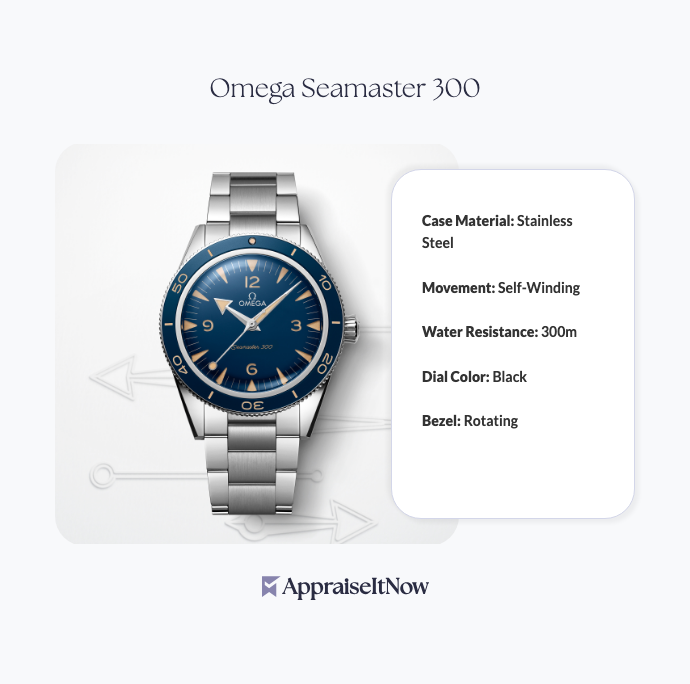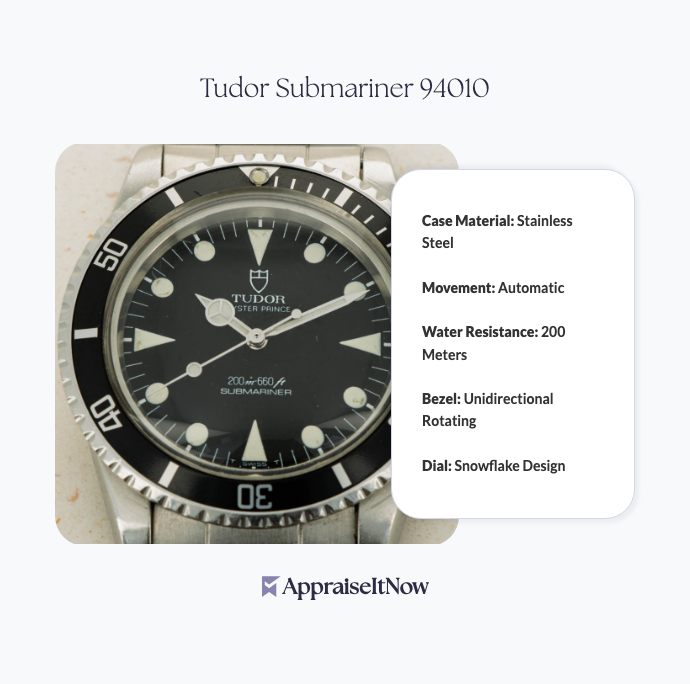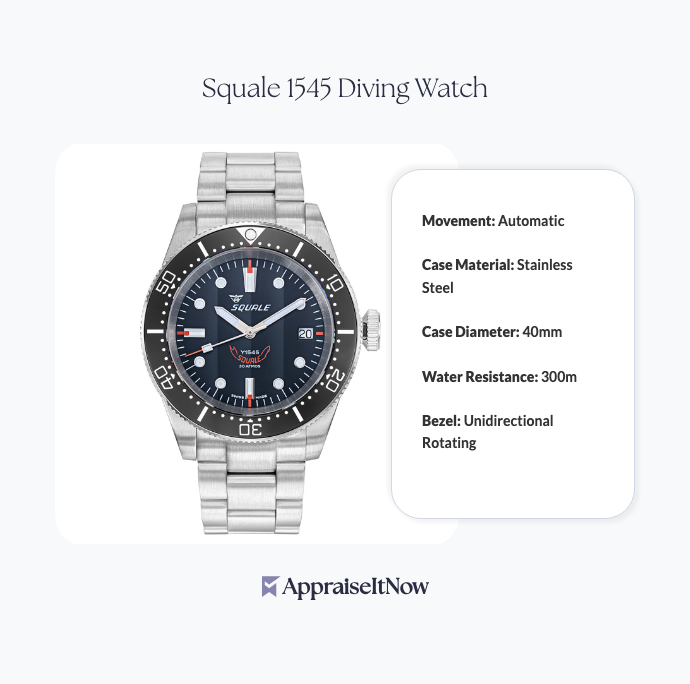<h1>How to Get Your Omega Seamaster 300 Appraised</h1>
<p>The Omega Seamaster 300 represents far more than just a functional timepiece—it's a piece of horological heritage that has captivated collectors since its debut in 1957. Whether you're insuring your watch, preparing it for sale, or establishing its value for estate purposes, understanding the appraisal process ensures you receive an accurate, defensible valuation of this iconic dive watch. Current market estimates place the Seamaster 300 in the <strong>$1,500 to $2,500 range</strong> for quality examples, though individual pieces may vary significantly based on condition, provenance, and specific model details.</p>
<h2>Why Your Seamaster 300 Deserves Professional Appraisal</h2>
<p>The Omega Seamaster 300's value extends beyond its stainless steel construction and self-winding movement. This watch has earned its status through proven reliability in extreme environments and its role in establishing Omega's legacy as a maker of purpose-built instruments. When you commission a professional appraisal, you're not just getting a price estimate—you're obtaining certified documentation that insurance companies, auction houses, and financial institutions recognize and accept.</p>
<p>Getting your Seamaster 300 appraised becomes particularly important if you're considering <a href="/blog/everything-you-need-to-know-about-jewelry-appraisals">jewelry appraisals</a> or specialized watch valuations. Unlike general <a href="/types/personal-property">personal property appraisals</a>, luxury watch appraisals require expertise in mechanical complications, historical significance, and market demand specific to Swiss horology. Your appraisal report serves as definitive documentation for insurance claims, estate settlements, and sales transactions.</p>
<div class="callout tip"><p><strong>Appraisal Advantage</strong></p>
<p>A certified Seamaster 300 appraisal provides independent verification of authenticity, condition, and fair market value—critical when insurance coverage or sales negotiations are at stake.</p></div>
<h2>Understanding Seamaster 300 Valuation Factors</h2>
<p>Several distinct factors drive your Seamaster 300's specific value within the broader market range. Appraisers evaluate these elements methodically to establish fair market value that reflects current demand and condition.</p>
<p><strong>Original case and dial integrity</strong> rank among the most significant value determinants. Does your Seamaster 300 retain its original stainless steel case with minimal polishing? Is the dial untouched with clear printing and lume that shows appropriate aging? These factors alone can swing value by 30-40% compared to refinished or altered examples. Appraisers photograph and document every aspect of the case and dial during their assessment.</p>
<p>The question of <strong>original versus replacement parts</strong> fundamentally affects valuation. Your Seamaster 300's self-winding movement should contain original components whenever possible. Replacement crowns, crystals, or hands reduce value relative to examples with complete original equipment. Service records documenting maintenance by authorized Omega technicians actually enhance value by demonstrating proper care throughout the watch's life.</p>
<p><strong>Condition and patina matter differently for vintage watches than modern ones.</strong> While a 1960s Seamaster 300 showing honest wear and appropriate aging commands respect among serious collectors, excessive polishing, refinishing, or missing parts diminishes appeal. The rotating bezel's condition—whether it rotates smoothly, maintains its markings, and shows appropriate wear—directly impacts desirability.</p>
<h2>Authentication and Documentation Requirements</h2>
<p>Before your appraisal appointment, gather all documentation that establishes provenance and authenticity. Original box, papers, or purchase receipts strengthen your valuation substantially. Even without these items, a professional appraiser can authenticate your Seamaster 300 through detailed examination of case markings, movement characteristics, and dial specifications particular to your reference number.</p>
<p>What documentation do you need for an accurate Seamaster 300 appraisal? Professional appraisers benefit from photographs showing your watch from multiple angles—dial, case back, bezel, bracelet/strap condition, and any serial numbers or reference markings. Service records, even from independent watchmakers, demonstrate maintenance history. Original purchase receipts or family documentation explaining the watch's provenance adds significant credibility to your appraisal.</p>
<p>The authentication process distinguishes your genuine Seamaster 300 from homages or counterfeits. Appraisers specializing in <a href="/blog/appraising-luxury-watches-determining-the-value-of-timepiece-investments">luxury watch valuations</a> examine case serial numbers, movement codes, dial specifications, and hands characteristics unique to specific production years. This expertise ensures your appraisal reflects genuine Omega heritage, not speculative attribution.</p>
<div class="callout note"><p><strong>Authentication Insight</strong></p>
<p>Detailed appraisal photographs and documentation serve as your lasting record of condition, helping establish insurance claims or authenticate ownership in future transactions.</p></div>
<h2>Market Value and Pricing Considerations</h2>
<p>The Seamaster 300's position in the vintage watch market reflects both its technical excellence and its cultural significance. Your watch's specific model year and reference number influence its value considerably. Earlier examples from the 1957-1960 period command premiums over later 1960s-1970s production, with rarity and condition being decisive factors.</p>
<p>How do appraisers determine the cased value of an Omega Seamaster 300? Professionals employ multiple valuation approaches simultaneously. <strong>Comparable sales analysis</strong> examines recent transactions of similar reference numbers in comparable condition through auction houses, specialty dealers, and private sales. <strong>Income approach</strong> considers the watch's role in a collector's portfolio or as an insurance asset. <strong>Cost approach</strong> evaluates replacement value should the original be lost or damaged. The intersection of these methods produces a defensible fair market value that withstands professional scrutiny.</p>
<p>Regional variations affect Seamaster 300 valuations. Watches with strong Commonwealth provenance may command premiums in British markets, while European collectors might favor examples with corresponding documentation. Understanding these nuances, professional appraisers position your valuation appropriately for your intended use—whether insurance, sale in a specific market, or estate purposes.</p>
<h2>Choosing Where and How to Get Your Seamaster 300 Appraised</h2>
<p>Professional appraisal services should employ credentialed experts holding certifications from organizations like the <strong>American Society of Appraisers (ASA)</strong>, the <strong>International Society of Appraisers (ISA)</strong>, or comparable horological credentials. AppraiseItNow connects you with USPAP-compliant appraisers experienced in <a href="/blog/what-you-need-to-know-about-rare-watch-appraisals">luxury watch valuations</a>, eliminating the uncertainty of finding qualified specialists.</p>
<p>Where should you seek your appraisal? Authorized Omega dealers offer expert perspective but may lack the independence required for certain purposes. Independent watch appraisers provide objective valuations free from sales incentives. Auction house specialists understand market demand through direct exposure to recent sales data. The ideal choice depends on your appraisal's purpose—insurance requires USPAP compliance, while estate planning benefits from specialized knowledge of probate requirements.</p>
<p>How much does a professional appraisal cost? Typical watch appraisals range from <strong>$200 to $500</strong> depending on complexity, though exceptional timepieces with elaborate provenance may require higher fees reflecting the appraiser's research investment. Your appraisal cost represents minimal insurance against misevaluation, particularly for watches valued in the $1,500-$2,500 range where modest percentage errors translate to significant dollar impacts.</p>
<div class="callout tip"><p><strong>Cost-Benefit Analysis</strong></p>
<p>A $300 appraisal protecting a $2,000 Seamaster 300 prevents insurance undervaluation costing you thousands in uncompensated losses.</p></div>
<h2>Condition Assessment and Value Impact</h2>
<p>Understanding how professional appraisers grade condition helps you anticipate your valuation. The Seamaster 300's 300-meter water resistance and sapphire crystal contribute durability, but condition assessment remains nuanced for vintage examples.</p>
<p>A pristine example showing minimal wear, with complete original equipment and perfect dial printing commands premium pricing near the <strong>$2,500 top range</strong>. Very good condition with light polishing, perhaps one replacement component, and good dial condition typically falls in the <strong>$2,000-$2,300 range</strong>. Good condition with moderate wear, careful refinishing, or several period-correct replacements lands around <strong>$1,500-$2,000</strong>. Fair condition with extensive wear, significant refinishing, or missing components may fall below $1,500, depending on rarity and specific reference number.</p>
<p>Service history significantly influences these grades. A Seamaster 300 showing an Omega service record dated 1985 suggests meticulous maintenance and appropriate authenticity. Recent service by reputable watchmakers demonstrates the owner's commitment to preservation. Conversely, evidence of amateur repair or non-professional service historically reduces collector appeal and valuation.</p>
<h2>Using Your Appraisal: Insurance, Sale, and Estate Purposes</h2>
<p>Your appraisal serves distinct purposes depending on your circumstances. For <strong>insurance purposes</strong>, USPAP-compliant appraisals document replacement value, enabling your insurer to establish appropriate coverage. Insurance companies accept independent appraisals from qualified professionals, protecting your asset against loss or damage. Update your appraisal every 3-5 years as market values shift, particularly important for collectible watches where demand fluctuates.</p>
<p>Preparing to <strong>sell your Seamaster 300</strong>? A professional appraisal establishes reserve prices for auctions or guides negotiations in private sales. Potential buyers appreciate independent valuations, accelerating transactions and building confidence in pricing. Auction houses often provide free pre-sale estimates, though independent appraisals offer objective perspective uninfluenced by their commission structure.</p>
<p><strong>Estate settlement and inheritance situations</strong> benefit tremendously from professional appraisals. When multiple heirs dispute watch valuations or tax authorities require asset documentation, certified appraisals provide defensible valuations. Appraisals also facilitate equitable distribution, helping executors allocate assets fairly among beneficiaries.</p>
<p>For <strong>loan collateral purposes</strong>, some specialized lenders accept appraised luxury watches as security. Your appraisal documentation enables lenders to establish appropriate loan-to-value ratios, making financing available should you need capital while retaining your Seamaster 300.</p>
<h2>Determining Authenticity Through Professional Appraisal</h2>
<p>How can you tell if your Omega Seamaster 300 is authentic? Professional appraisers possess detailed knowledge of Seamaster 300 production across decades, including subtle variations that distinguish genuine examples from homages or counterfeits.</p>
<p>Authentic Seamaster 300s display specific characteristics particular to their production year and reference number. Case geometry, bezel markings, dial specifications including printing style and lume characteristics, hands design, and movement codes all bear unique signatures of genuine Omega production. Appraisers examine these elements microscopically, comparing your watch against known authentic examples and documented specifications.</p>
<p>Dial quality proves particularly diagnostic—genuine Seamaster 300 dials maintain consistent printing, appropriate lume aging, and specific font characteristics. Case serial numbers align with movement codes and production records. The movement's caliber designation, jewel count, and component finishing match Omega's specifications for your reference number and production period.</p>
<div class="callout note"><p><strong>Authentication Value</strong></p>
<p>Professional authentication documentation proves invaluable if questions arise during future sales or insurance claims, protecting your investment's credibility.</p></div>
<h2>Beyond Basic Appraisal: Market Insights and Rarity Factors</h2>
<p>Certain Seamaster reference numbers command particular collector attention, affecting valuation significantly. Are certain Seamaster models or reference numbers more sought-after? Yes—specific references like the CK 2913 from the 1950s or the 165.024 from the 1960s represent apex collectibility within the Seamaster 300 lineage. Rarity, historical documentation, and documented ownership all elevate these models substantially above typical examples.</p>
<p>Your appraisal should address these nuances. Professional appraisers recognize when your watch represents a particularly desirable variant within the broader Seamaster 300 category. They understand which production years saw quality variations, which references connected to notable historical uses, and which examples command premium collector interest.</p>
<p>The influence of market demand on watch valuations parallels other <a href="/types/memorabilia-and-collectibles">memorabilia and collectibles</a>—when films feature vintage Seamasters or celebrity ownership becomes documented, demand spikes temporarily. Appraisers contextualize your valuation within current market sentiment while grounding assessments in historical pricing patterns and fundamental scarcity factors.</p>
<h2>Appraisal Reports and Their Long-Term Value</h2>
<p>Your completed appraisal generates formal documentation serving multiple purposes throughout your Seamaster 300's ownership journey. Professional reports include detailed descriptions, high-resolution photographs, condition assessments, comparable sales analysis, and the appraiser's signed certification of fair market value. This documentation creates lasting records that accompany your watch through insurance renewals, sales, or inheritance.</p>
<p>Keep your appraisal report with other important documents—copies with your insurance agent, originals in secure storage alongside your watch. Appraisals typically remain valid for 3-5 years before market shifts warrant updating. If you significantly service or restore your Seamaster 300, reappraisal documents the condition changes and updated value.</p>
<p>The appraisal also preserves current market conditions in written form. Should you reference the valuation years later, the report captures specific comparable sales, market conditions, and appraiser methodology that informed the determination. This temporal documentation proves valuable during estate disputes or insurance claims where historical context matters.</p>
<hr />
<div class="callout note"><p><strong>Key Takeaway</strong></p>
<p>A certified appraisal of your Omega Seamaster 300 provides essential documentation for insurance protection, sale preparation, or estate planning. Professional expertise ensures accurate valuation reflecting your watch's condition, provenance, and position within the collector's market, giving you confidence that your horological investment receives appropriate recognition and protection.</p></div>







.avif)







